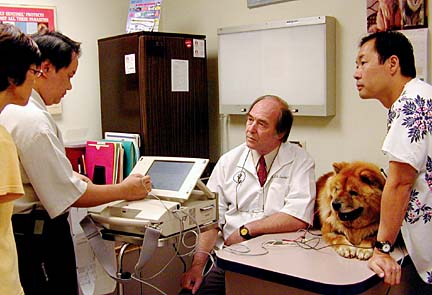


Kachina, 12, and Mirren, 8, have computer-programmed heart rates, and every beat is recorded. Pacemakers give pooches
a new leash on lifeTwo dogs are fortunate to
By Helen Altonn
have owners who had the will,
and doctors who supplied the way.
Star-BulletinThe lives of the two dogs have been extended and restored to normal with the latest model of Medtronic Inc. cardiac pacemakers.
"It's actually miraculous when you think about it," said Jeannie Lum, University of Hawaii philosophy of education professor who owns Kachina, a chow chow.
Kachina's red coat is thick and shiny; her eyes are clear, and she's more alert, Lum s(long-s)aid.
"I think everything kicked in to the degree that I think she's in better health than she was for a couple years."
The dog had lost hair because of a yeast infection, and her condition was complicated by hypothyroidism.
Dr. Patrick Leadbeater, Kahala Pet Hospital veterinarian, installed Kachina's pacemaker Dec. 5. During a recent checkup, he said her physical
condition was so much better, "I almost wouldn't recognize her."
Dr. W. Philip Kau of the Animal Hospital of Hawaii, performed Mirren's pacemaker procedure Feb. 21 with Dr. Kenneth Bruecker, a veterinary surgeon from Ventura, Calif.
Kau performed the first cardiac pacemaker procedure on a dog in 1981. Medtronic donates pacemakers for veterinary use that have expired shelf life for humans.
The surgery isn't common in canines, but pet owners should know it's an option, Leadbeater said.
"There is a lack of awareness by many folks that something like this is even possible."
Randy Hoo, Medtronic clinical specialist in Honolulu, programmed the dogs' pacemakers and assisted with the installation in the operating room, just as with human patients in hospitals.
"It's really quite a unique experience," Leadbeater said.
The resting heart rate for a dog should be about 80 beats per minute, the doctors said.
But Kachina's was about 30 before the operation, and Mirren's had fallen to 41.
Hoo set the pacemakers for a resting rate of 80 beats per minute and a high of 140 when the dogs are excited or exercising.
He programmed them to slow to about 60 during sleep and back to 80 or more if the dogs get up at night.
Hoo said the new generation pacemaker is small, extremely efficient and has amazing diagnostics.
It will store more than four years of information - every heartbeat, he said.
Lum acquired Kachina, named for the Hopi Indian doll, from a rescue group for the chow chow breed in Santa Rosa, Calif. She was then at the University of California, Berkeley.
The dog's heart problem was detected in September by Dr. Richard Fujie at the Kahala Pet Hospital.
Leadbeater sent electrocardiogram strips to a mainland cardiologist "to see if we were missing anything," and the diagnosis was confirmed.
Some medicines will help for a short time, but they don't raise the heart rate very well, Leadbeater said, so Lum chose to give Kachina a pacemaker.
Leadbeater lodged the device - about the size of a vanilla wafer - in a pouch between two muscle layers.
He attached electrodes to the heart on a footlong wire from the pacemaker in the abdominal wall through the dog's diaphragm.
Placement of the electrodes is critical and difficult because the heart is beating, Leadbeater said.
"Anatomically, there is an appropriate place, but you have only one shot at it."
Checking Kachina recently with an electrocardiogram, Hoo said, "The pacemaker is fine. The battery is fine. The lead is excellent. Perfect."
The new model can record about four million heartbeats and produce graphs for analysis and reprogramming of the heart rate if needed.
"None of this was possible with other pacemakers," Leadbeater said. "It was a static unit with a battery before."
Hoo slowed the pacemaker to see Kachina's own heartbeat - still at 30 or less. She couldn't survive if it remained that way, Leadbeater said.
"The company figures four to five years of life or longer in the pacemaker," he said.
"A healthy chow should live to 15, or longer. We'll be lucky to go longer now."
Lum sent Hoo and Medtronic a box of candy on Valentine's Day to thank them for Kachina's "gift of life."
Mirren, believed to be a mixture of white Labrador and white shepherd, belongs to Karen Kaisan and her husband, Rafael Mercado.
"We're nicknaming her 'honeymoon,' " Kaisan said, explaining that she and her husband used their honeymoon money to pay for the surgery.
They were married in November and planned a December honeymoon to his homeland of Puerto Rico to visit his family.
But Mirren began collapsing during walks, and her veterinarian, Dr. Pauline Koreyasu, discovered she had a severe heart blockage.
"She said a pacemaker would be the only solution, and we would have to decide if we wanted to invest the money to do that," Kaisan said.
"I made the decision with my husband to do it because she's a special dog."
Mirren had been a volunteer with the Hawaiian Humane Society's pet-visitation program when she was younger, visiting hundreds of seniors at the Hale Nani Rehabilitation and Nursing Center, Kaisan said.